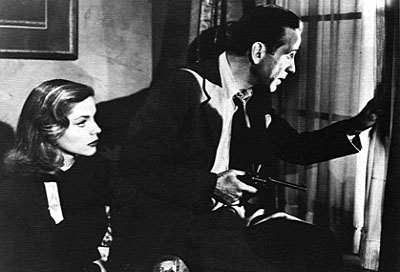He told Warners he would need $50,000 to buy a story he assured them could be transformed into a tough yet romantic vehicle for the two stars. $5,000 went to Raymond Chandler, the author of the crime thriller The Big Sleep. The remaining $45,000 went to Hawks. When he looked at the finished version, Chandler would be the first to say that Hawks had earned his cut. For, when completed, The Big Sleep had been through so many rewrites that it had gone from being an existential meditation on modern life as told through the eyes of a world-weary detective, to a sexy, funny, hair-raising trip (on rationed gas) through '40s Los Angeles.
The Big Sleep's narrative convolution is, far from being frustrating, a major source of joy in the film. Characters like deluded little Harry Jones enter and exit without fanfare; others, like soldier-of-fortune Sean Regan, are somehow major characters without ever being seen on screen. And there are others: General Sternwood, a shriveled hothouse flower; Geiger, the fastidiously sleazy bookstore proprietor; Eddie Mars, the shady casino owner; Carol Lundgren, the grifter-assassin; Art Huck, the lowlife filling station owner; Joe Brody, the dumb, ill-fated hood and Agnes, his treacherous lady friend; the cruel Canino and a host of others. Giggling killers and gruesome butlers pass through without even the courtesy of a name. A sideshow of criminality wanders in and out of The Big Sleep like so many underworld supernumeraries, crowding the film not so much with "characters," but with tiny, finely-etched, one-note portrayals of deceit and self-interest.
The most famous loose end in the story concerns a chauffeur, one Owen Taylor, who turns up dead in a water-logged Packard, "washing around off Lido Pier." Questions on the set arose as to who, in the carnival of conflicting motives that made the film a Chinese box of mayhem, actually did kill Owen Taylor? Hawks realized he didn't know, and successive calls were put in to screenwriters Leigh Brackett, Jules Furthman, and William Faulkner; they didn't know, either. Finally, Chandler himself was reached; no, he said, he guessed he didn't know, either. Editor Christian Nyby remembered years later that work on the film stopped for two days while a way out of this narrative cul-de-sac was sought. At that point, Hawks realized it didn't matter who killed Owen Taylor, and the film went ahead, its atmosphere of treachery somehow improved by the ambiguity.
What The Big Sleep did have, most of all, was an actress like Lauren Bacall. It was Hawks and his wife Slim who had discovered Bacall, a shy, willowy cover model for Harper's Bazaar, whose real name was Betty Jane Perske. Hawks, a gambler, had signed the girl to a personal contract and then set to remaking her as a screen siren. According to a half-dozen different versions of the story, Hawks had Bacall declaiming poetry at full throat in deserted Malibu canyons in order to heighten her naturally gravelly baritone. There were still some rough edges; for many years, one of the weirdest rumors was that Bacall's smoky singing voice in To Have and Have Not had been dubbed by the youthful Andy Williams. But by and large, Lauren Bacall was a polished performer by the time The Big Sleep rolled, and viewers and the public responded. As critic James Agee said at the time, "Lauren Bacall has cinema personality to burn. She has a javelin-like vitality, a born dancer's eloquence of movement, a fierce female shrewdness, and a special sweet sourness. With these faculties, plus a stone-crushing self-confidence and a trombone voice, she manages to get across the toughest girl Hollywood has dreamed of in a long, long while."
So complete was Bacall's success that after the film was previewed to servicemen in 1945, additional scenes between Bogart and Bacall were shot to heighten the sexual tension between Bogart and Bacall. Thus, a year after the film had begun shooting, Hawks and company returned to the set to shoot the famous "horse racing" patter between Bogart and Bacall, the most outrageous extended double entendre the screen had yet seen. Indeed, the entire film somehow manages to be as impish as it is violent, an erotic gangland picaresque played productively against the metropolitan gloom of Chandler's original novel.
Shot during wartime, the film turns the draft-induced "man shortage" into a satyr's fantasy; sloe-eyed heiresses, hash-slingers with come-hither looks, and horny lady cab drivers brazenly proposition Marlowe, who regrettably stiff-arms most of them in the name of business. A rainy-day tryst behind demurely lowered blinds with a beautiful bookstore clerk (Dorothy Malone, in one of her earliest roles, is the exception, an artful and sensual addition to Chandler's story.
Romance and an easy, comfortable sexuality are at the heart of The Big Sleep's accomplishment. Philip Marlowe, the knightly loner of the Chandler novels, has been transformed by Bogart, Hawks and certainly by Bacall into a relaxed, chuckling professional, comfortable with the ways of this upside-down world, and agile enough to play all its angles. For Bogart's Philip Marlowe, the nearly-anarchic plot never provides the reassuring stability of the whodunit; at the end of the film, we hardly know which of the film's multitude of crimes has been solved. What has become meaningful for Marlowe in this absurd universe is love, and the many paradoxes Bacall brings to Vivian Sternwood--she is sly and naïve, brave and fearful, witty and earnest, elegant and earthy--provide a startling depth of character in the midst of Grand Guignol Gargoyles and cardboard gangsters. In the dangerous night world of The Big Sleep, on its deserted rain-slicked streets and in its cold ritzy mansions, the capable Marlowe is truly surprised only once: when he discovers unadulterated loyalty and love in the least likely place.


